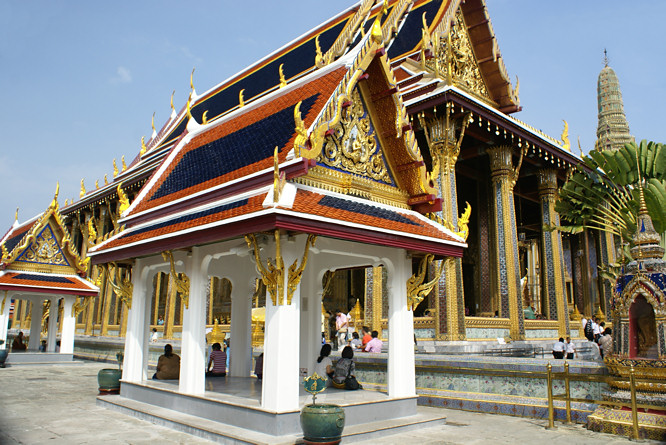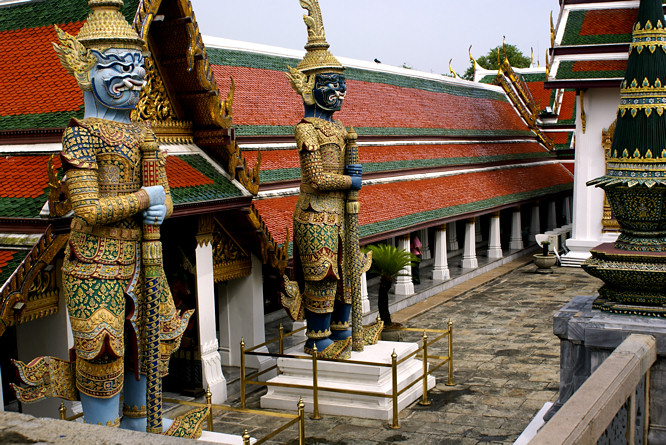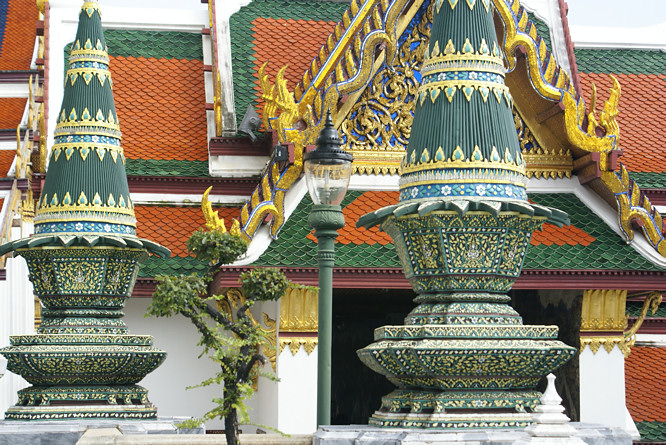Bangkok Wat Phra Kaew Temple of the Emerald Buddha Complex
The Emerald Buddha, which is believed to have been created in India in 43 BC, travelled to Sri Lanka three hundred years later, then to Cambodia in 457 AD, to Ayutthaya in 1434 following the capture of Angkor Wat, to Chiang Saen a hundred years later, to Chiang Rai, then to Lamphang until 1468, to Chiang Mai until 1552, to Luang Prabang until 1564, to the new capital in Vientiane until 1779, and finally to Thonburi until 22 March, 1784, when it was installed at Wat Phra Kaew temple in the grounds of the Thai Royal Grand Palace, in Rattanakosin, Bangkok where it stays to this day. It is kept in the main building of the temple, called the Ubosoth.

The architectural style of the Wat Phra Kaew Temple of the Emerald Buddha is called Rattanakosin style or old Bangkok style. The main temple of the Emerald Buddha is very elegantly decorated and looks similar to the main temple in ancient capital of Ayudhya. The roof is covered in highly glazed orange and green tiles. The pillars stand on marble pediments and are inlaid with mosaic. The entrance is guarded by a pair of 16 ft (5m) mythical giants called yakshis.
The Ubosoth large temple hall was construct by King Rama I. It was King Rama III commanded that the walls be redecorated with stucco (stuck on) mouldings, gilt and decorated with glass mosaics. The six doors of the Assembly Hall are each guarded by a pair of 13th century Khmer-style lions.
What I found really strange was that despite it's national importance, Wat Phra Kaew is the only temple in Thailand that doesn't have any resident monks, and so is not a seat of Buddhist learning. In the middle of the complex is a square building surrounded by columns that support a traditional Thai roof. This is the temple Library called Phra Monodop. It is next to the big golden Phra Si Ratana Chedi. The Thais' and Cambodians share the same cultural and religious roots. There is a large model of the Angkor Wat temple complex, the most sacred of all Cambodian Shrines.

A hermit's bronze image, which is believed to have healing powers, is installed in a sala on the western side of the temple. It is near the entry gate. It is a black stone statue, considered a patron of medicine, before which relatives of the sick and infirm pay respects and make offerings of joss sticks, fruit, flowers, and candles. Statues of elephants, which symbolize independence and power, are seen all around the complex.
As Thai kings fought wars mounted on elephants, it has become customary for parents to make their children circumambulate the elephant three times with the belief that that it would bring them strength. The head of an elephant statue is also rubbed for good luck; this act of the people is reflected in the smoothness of the surface of elephant statues here. After exiting Wat Phra Kaew Temple compound, you enter the adjoining Royal Grand Palace and the old residential complex.

Travel books

